Flying Tiger Copenhagen Assignment PDF
VerifiedAdded on 2021/08/03
|6
|1432
|459
AI Summary
Contribute Materials
Your contribution can guide someone’s learning journey. Share your
documents today.
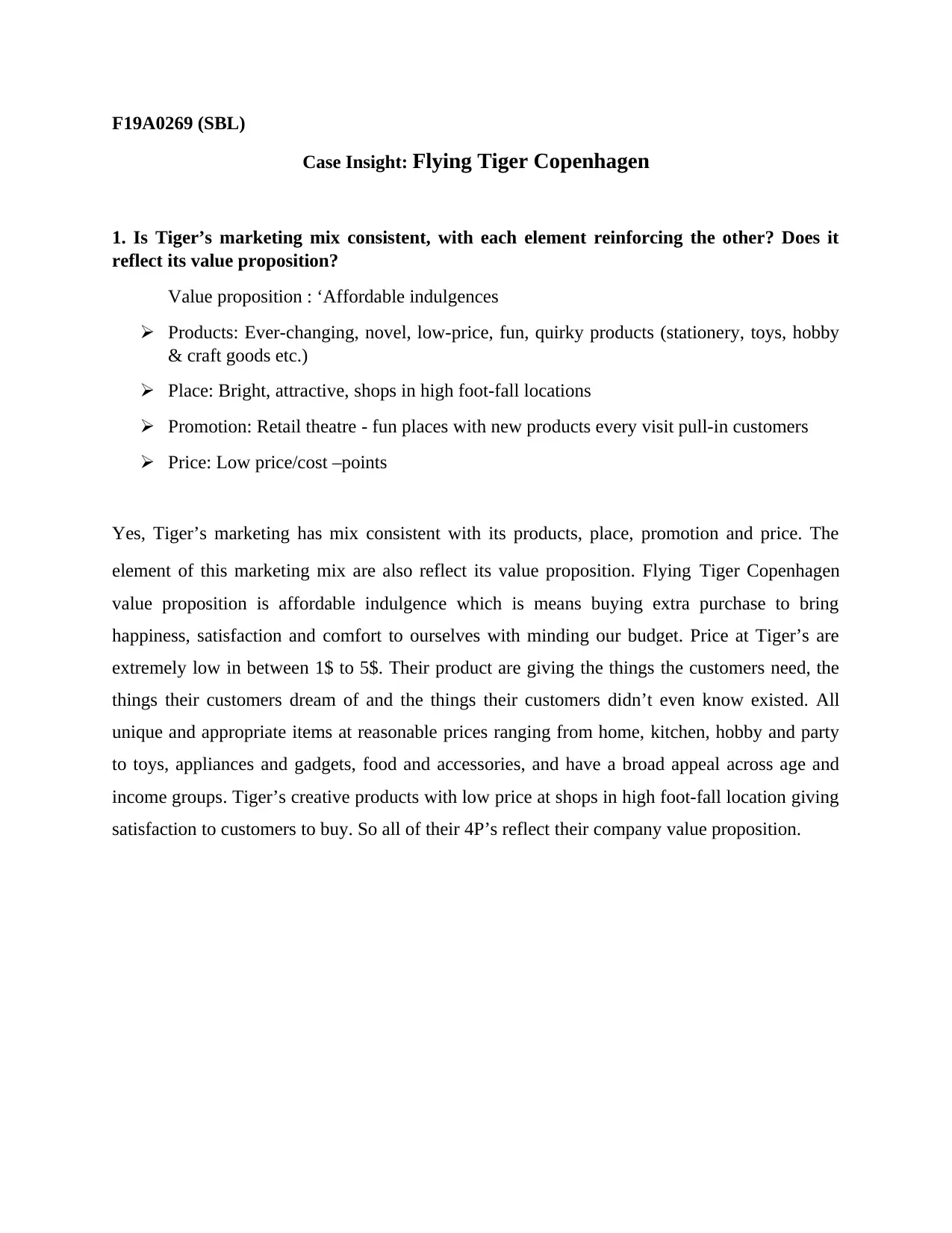
F19A0269 (SBL)
Case Insight: Flying Tiger Copenhagen
1. Is Tiger’s marketing mix consistent, with each element reinforcing the other? Does it
reflect its value proposition?
Value proposition : ‘Affordable indulgences
Products: Ever-changing, novel, low-price, fun, quirky products (stationery, toys, hobby
& craft goods etc.)
Place: Bright, attractive, shops in high foot-fall locations
Promotion: Retail theatre - fun places with new products every visit pull-in customers
Price: Low price/cost –points
Yes, Tiger’s marketing has mix consistent with its products, place, promotion and price. The
element of this marketing mix are also reflect its value proposition. Flying Tiger Copenhagen
value proposition is affordable indulgence which is means buying extra purchase to bring
happiness, satisfaction and comfort to ourselves with minding our budget. Price at Tiger’s are
extremely low in between 1$ to 5$. Their product are giving the things the customers need, the
things their customers dream of and the things their customers didn’t even know existed. All
unique and appropriate items at reasonable prices ranging from home, kitchen, hobby and party
to toys, appliances and gadgets, food and accessories, and have a broad appeal across age and
income groups. Tiger’s creative products with low price at shops in high foot-fall location giving
satisfaction to customers to buy. So all of their 4P’s reflect their company value proposition.
Case Insight: Flying Tiger Copenhagen
1. Is Tiger’s marketing mix consistent, with each element reinforcing the other? Does it
reflect its value proposition?
Value proposition : ‘Affordable indulgences
Products: Ever-changing, novel, low-price, fun, quirky products (stationery, toys, hobby
& craft goods etc.)
Place: Bright, attractive, shops in high foot-fall locations
Promotion: Retail theatre - fun places with new products every visit pull-in customers
Price: Low price/cost –points
Yes, Tiger’s marketing has mix consistent with its products, place, promotion and price. The
element of this marketing mix are also reflect its value proposition. Flying Tiger Copenhagen
value proposition is affordable indulgence which is means buying extra purchase to bring
happiness, satisfaction and comfort to ourselves with minding our budget. Price at Tiger’s are
extremely low in between 1$ to 5$. Their product are giving the things the customers need, the
things their customers dream of and the things their customers didn’t even know existed. All
unique and appropriate items at reasonable prices ranging from home, kitchen, hobby and party
to toys, appliances and gadgets, food and accessories, and have a broad appeal across age and
income groups. Tiger’s creative products with low price at shops in high foot-fall location giving
satisfaction to customers to buy. So all of their 4P’s reflect their company value proposition.
Secure Best Marks with AI Grader
Need help grading? Try our AI Grader for instant feedback on your assignments.
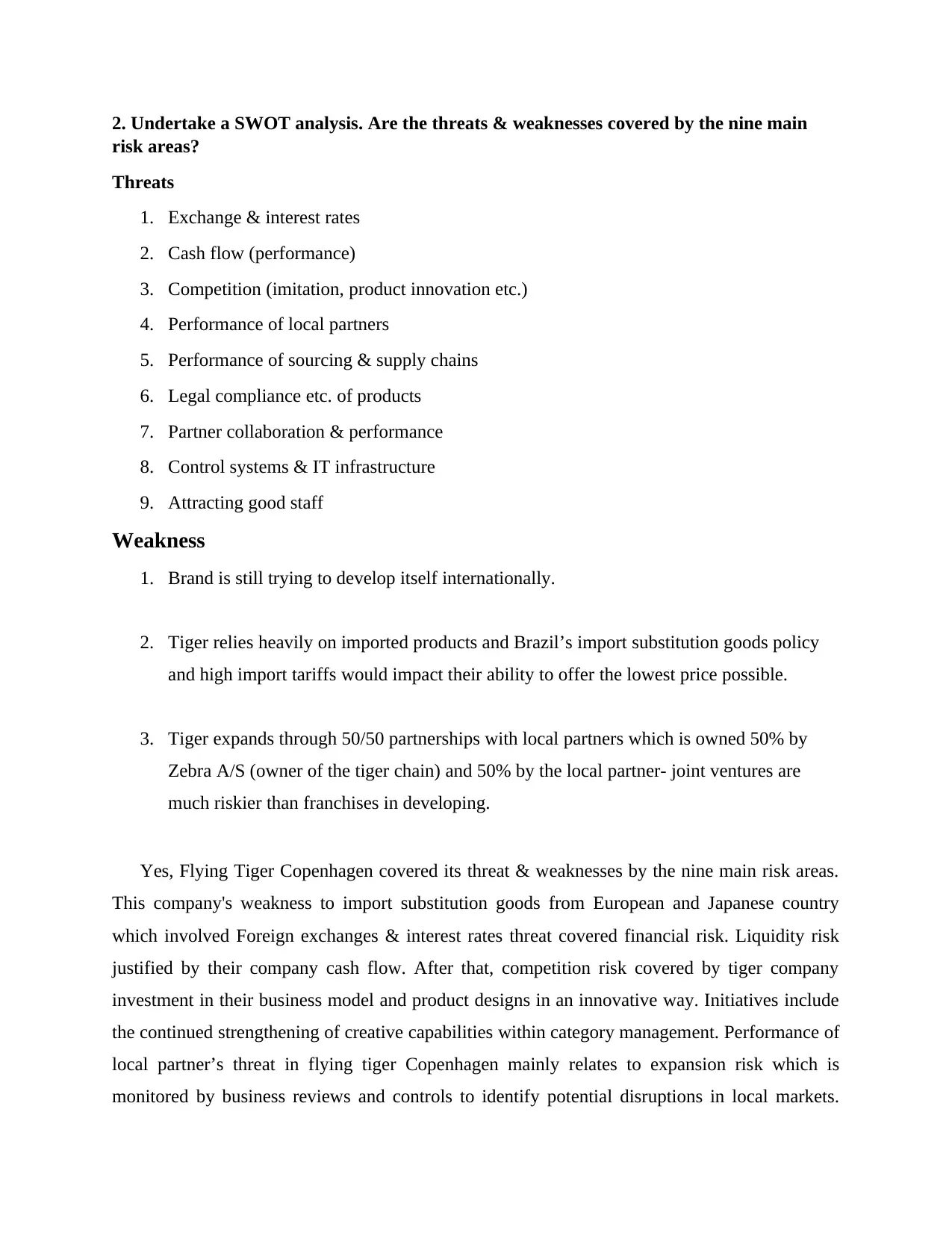
2. Undertake a SWOT analysis. Are the threats & weaknesses covered by the nine main
risk areas?
Threats
1. Exchange & interest rates
2. Cash flow (performance)
3. Competition (imitation, product innovation etc.)
4. Performance of local partners
5. Performance of sourcing & supply chains
6. Legal compliance etc. of products
7. Partner collaboration & performance
8. Control systems & IT infrastructure
9. Attracting good staff
Weakness
1. Brand is still trying to develop itself internationally.
2. Tiger relies heavily on imported products and Brazil’s import substitution goods policy
and high import tariffs would impact their ability to offer the lowest price possible.
3. Tiger expands through 50/50 partnerships with local partners which is owned 50% by
Zebra A/S (owner of the tiger chain) and 50% by the local partner- joint ventures are
much riskier than franchises in developing.
Yes, Flying Tiger Copenhagen covered its threat & weaknesses by the nine main risk areas.
This company's weakness to import substitution goods from European and Japanese country
which involved Foreign exchanges & interest rates threat covered financial risk. Liquidity risk
justified by their company cash flow. After that, competition risk covered by tiger company
investment in their business model and product designs in an innovative way. Initiatives include
the continued strengthening of creative capabilities within category management. Performance of
local partner’s threat in flying tiger Copenhagen mainly relates to expansion risk which is
monitored by business reviews and controls to identify potential disruptions in local markets.
risk areas?
Threats
1. Exchange & interest rates
2. Cash flow (performance)
3. Competition (imitation, product innovation etc.)
4. Performance of local partners
5. Performance of sourcing & supply chains
6. Legal compliance etc. of products
7. Partner collaboration & performance
8. Control systems & IT infrastructure
9. Attracting good staff
Weakness
1. Brand is still trying to develop itself internationally.
2. Tiger relies heavily on imported products and Brazil’s import substitution goods policy
and high import tariffs would impact their ability to offer the lowest price possible.
3. Tiger expands through 50/50 partnerships with local partners which is owned 50% by
Zebra A/S (owner of the tiger chain) and 50% by the local partner- joint ventures are
much riskier than franchises in developing.
Yes, Flying Tiger Copenhagen covered its threat & weaknesses by the nine main risk areas.
This company's weakness to import substitution goods from European and Japanese country
which involved Foreign exchanges & interest rates threat covered financial risk. Liquidity risk
justified by their company cash flow. After that, competition risk covered by tiger company
investment in their business model and product designs in an innovative way. Initiatives include
the continued strengthening of creative capabilities within category management. Performance of
local partner’s threat in flying tiger Copenhagen mainly relates to expansion risk which is
monitored by business reviews and controls to identify potential disruptions in local markets.
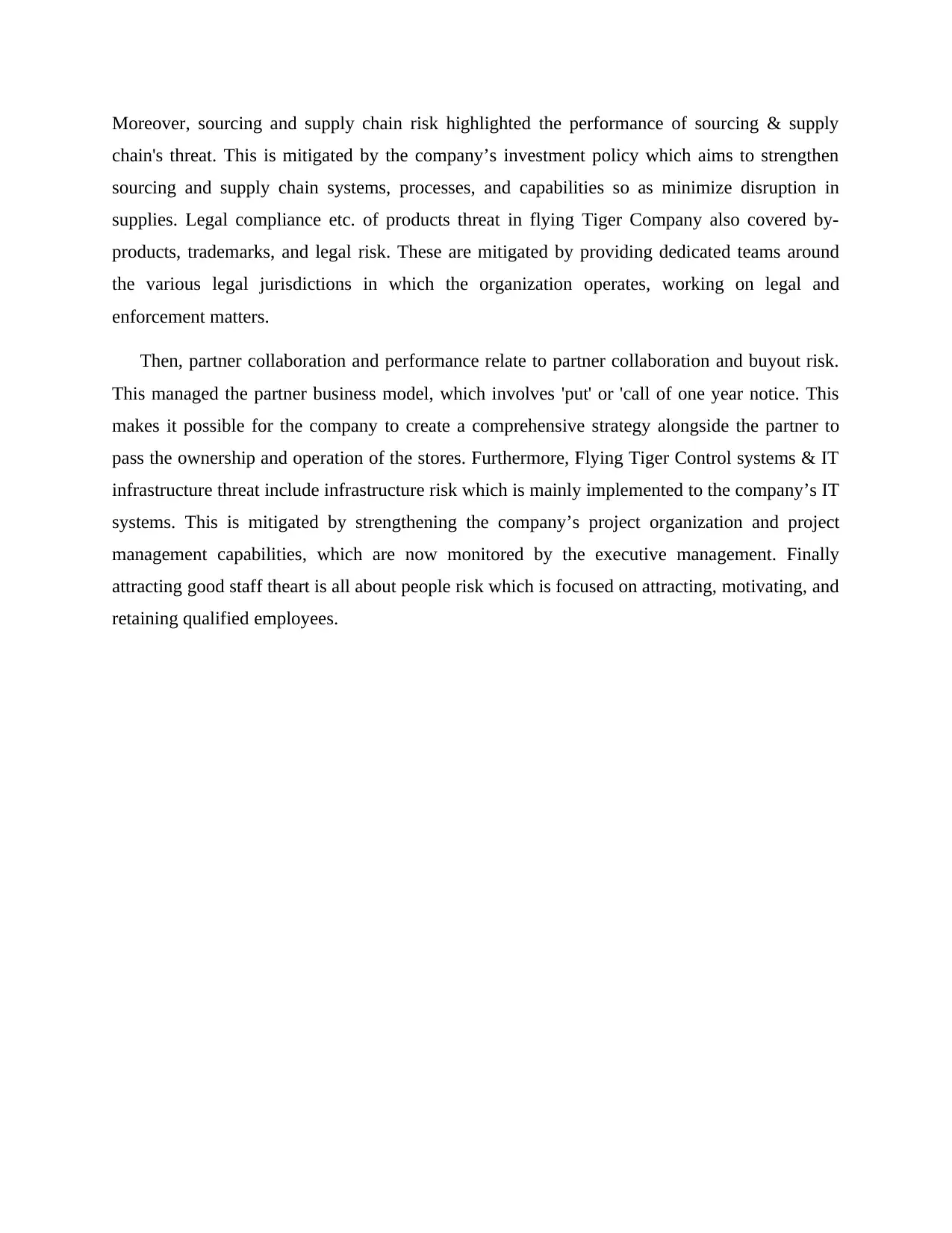
Moreover, sourcing and supply chain risk highlighted the performance of sourcing & supply
chain's threat. This is mitigated by the company’s investment policy which aims to strengthen
sourcing and supply chain systems, processes, and capabilities so as minimize disruption in
supplies. Legal compliance etc. of products threat in flying Tiger Company also covered by-
products, trademarks, and legal risk. These are mitigated by providing dedicated teams around
the various legal jurisdictions in which the organization operates, working on legal and
enforcement matters.
Then, partner collaboration and performance relate to partner collaboration and buyout risk.
This managed the partner business model, which involves 'put' or 'call of one year notice. This
makes it possible for the company to create a comprehensive strategy alongside the partner to
pass the ownership and operation of the stores. Furthermore, Flying Tiger Control systems & IT
infrastructure threat include infrastructure risk which is mainly implemented to the company’s IT
systems. This is mitigated by strengthening the company’s project organization and project
management capabilities, which are now monitored by the executive management. Finally
attracting good staff theart is all about people risk which is focused on attracting, motivating, and
retaining qualified employees.
chain's threat. This is mitigated by the company’s investment policy which aims to strengthen
sourcing and supply chain systems, processes, and capabilities so as minimize disruption in
supplies. Legal compliance etc. of products threat in flying Tiger Company also covered by-
products, trademarks, and legal risk. These are mitigated by providing dedicated teams around
the various legal jurisdictions in which the organization operates, working on legal and
enforcement matters.
Then, partner collaboration and performance relate to partner collaboration and buyout risk.
This managed the partner business model, which involves 'put' or 'call of one year notice. This
makes it possible for the company to create a comprehensive strategy alongside the partner to
pass the ownership and operation of the stores. Furthermore, Flying Tiger Control systems & IT
infrastructure threat include infrastructure risk which is mainly implemented to the company’s IT
systems. This is mitigated by strengthening the company’s project organization and project
management capabilities, which are now monitored by the executive management. Finally
attracting good staff theart is all about people risk which is focused on attracting, motivating, and
retaining qualified employees.
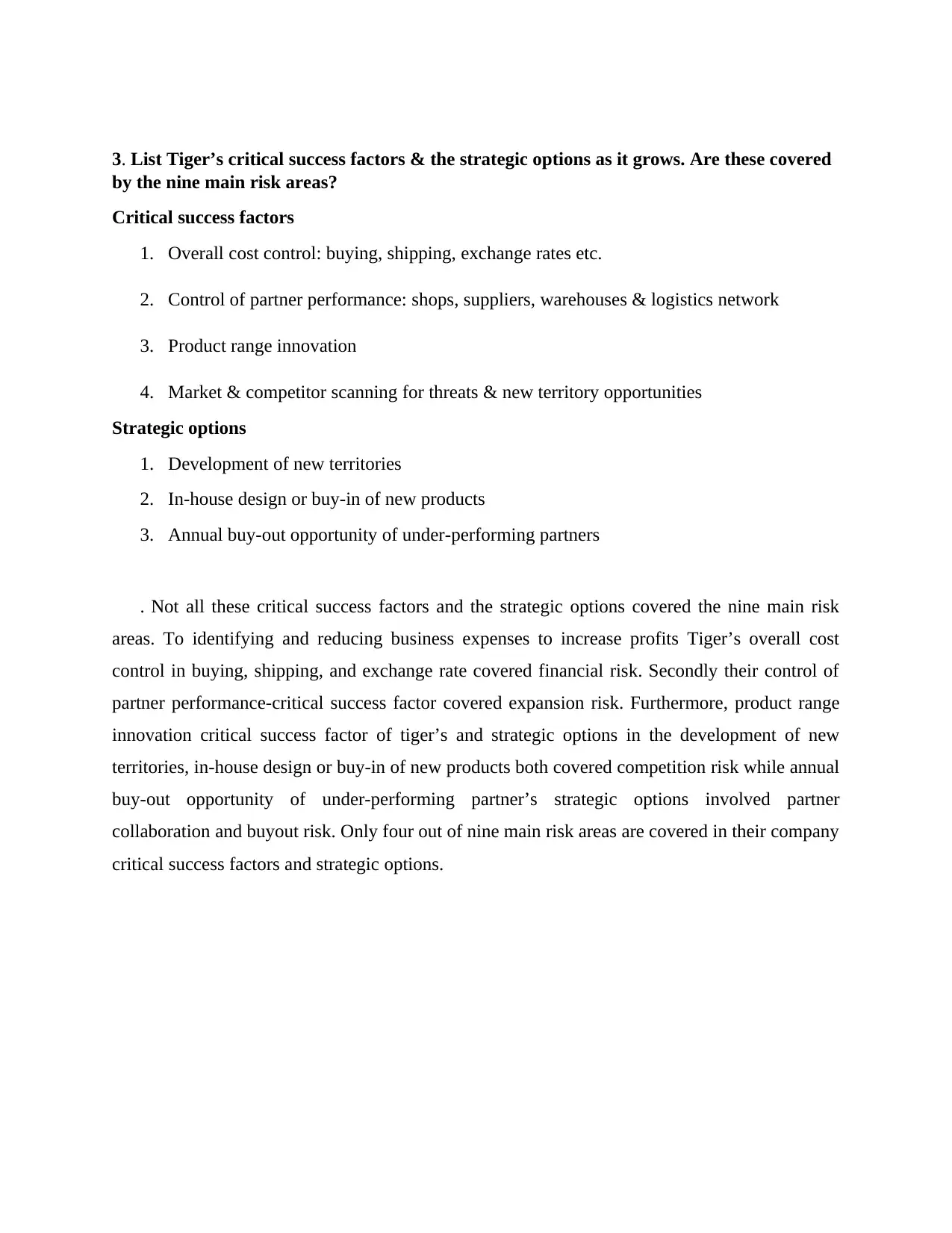
3. List Tiger’s critical success factors & the strategic options as it grows. Are these covered
by the nine main risk areas?
Critical success factors
1. Overall cost control: buying, shipping, exchange rates etc.
2. Control of partner performance: shops, suppliers, warehouses & logistics network
3. Product range innovation
4. Market & competitor scanning for threats & new territory opportunities
Strategic options
1. Development of new territories
2. In-house design or buy-in of new products
3. Annual buy-out opportunity of under-performing partners
. Not all these critical success factors and the strategic options covered the nine main risk
areas. To identifying and reducing business expenses to increase profits Tiger’s overall cost
control in buying, shipping, and exchange rate covered financial risk. Secondly their control of
partner performance-critical success factor covered expansion risk. Furthermore, product range
innovation critical success factor of tiger’s and strategic options in the development of new
territories, in-house design or buy-in of new products both covered competition risk while annual
buy-out opportunity of under-performing partner’s strategic options involved partner
collaboration and buyout risk. Only four out of nine main risk areas are covered in their company
critical success factors and strategic options.
by the nine main risk areas?
Critical success factors
1. Overall cost control: buying, shipping, exchange rates etc.
2. Control of partner performance: shops, suppliers, warehouses & logistics network
3. Product range innovation
4. Market & competitor scanning for threats & new territory opportunities
Strategic options
1. Development of new territories
2. In-house design or buy-in of new products
3. Annual buy-out opportunity of under-performing partners
. Not all these critical success factors and the strategic options covered the nine main risk
areas. To identifying and reducing business expenses to increase profits Tiger’s overall cost
control in buying, shipping, and exchange rate covered financial risk. Secondly their control of
partner performance-critical success factor covered expansion risk. Furthermore, product range
innovation critical success factor of tiger’s and strategic options in the development of new
territories, in-house design or buy-in of new products both covered competition risk while annual
buy-out opportunity of under-performing partner’s strategic options involved partner
collaboration and buyout risk. Only four out of nine main risk areas are covered in their company
critical success factors and strategic options.
Secure Best Marks with AI Grader
Need help grading? Try our AI Grader for instant feedback on your assignments.

4. Is the Tiger growth & expansion model consistent and coherent?
Yes, Tiger's growth & expansion model consistent and coherent. The growth model can
be achieved by practices like adding new locations, investing in customer acquisition. The
company growth model increasing comparable-store sales growth through the introduction of
new products, conducting marketing to drive up the volume of purchase and the frequency of
store visits. Increasing store penetration in existing markets by opening new stores. In the
expansion model, Tiger is owned by Zebra A/S. tiger has expanded by offering a 50-50
partnership with local partners who are offered exclusive territories that might be large cities,
regions, or even small countries. By this we can understand Flying Tiger’s process of expanding
to increase their company size consistently and coherently.
Yes, Tiger's growth & expansion model consistent and coherent. The growth model can
be achieved by practices like adding new locations, investing in customer acquisition. The
company growth model increasing comparable-store sales growth through the introduction of
new products, conducting marketing to drive up the volume of purchase and the frequency of
store visits. Increasing store penetration in existing markets by opening new stores. In the
expansion model, Tiger is owned by Zebra A/S. tiger has expanded by offering a 50-50
partnership with local partners who are offered exclusive territories that might be large cities,
regions, or even small countries. By this we can understand Flying Tiger’s process of expanding
to increase their company size consistently and coherently.
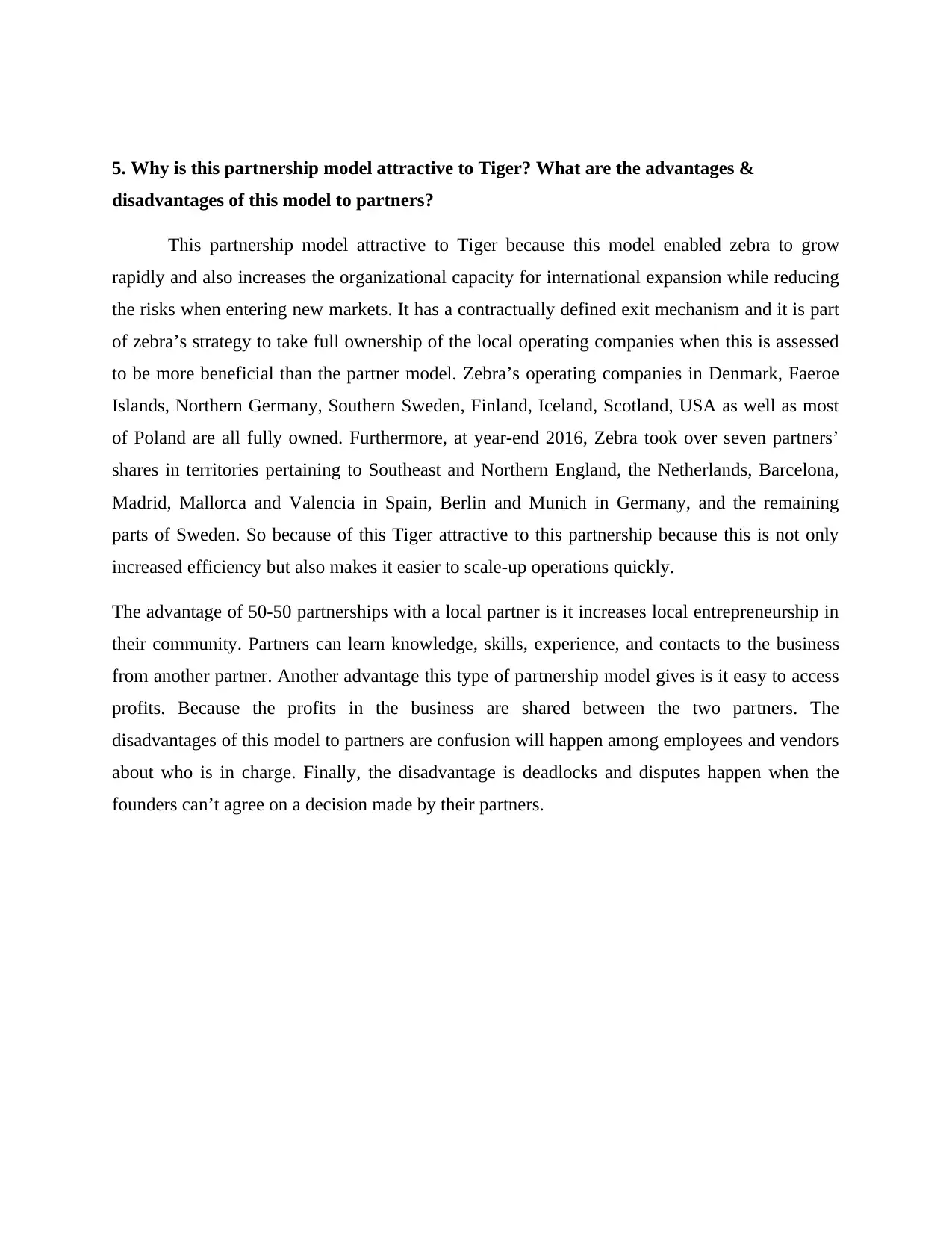
5. Why is this partnership model attractive to Tiger? What are the advantages &
disadvantages of this model to partners?
This partnership model attractive to Tiger because this model enabled zebra to grow
rapidly and also increases the organizational capacity for international expansion while reducing
the risks when entering new markets. It has a contractually defined exit mechanism and it is part
of zebra’s strategy to take full ownership of the local operating companies when this is assessed
to be more beneficial than the partner model. Zebra’s operating companies in Denmark, Faeroe
Islands, Northern Germany, Southern Sweden, Finland, Iceland, Scotland, USA as well as most
of Poland are all fully owned. Furthermore, at year-end 2016, Zebra took over seven partners’
shares in territories pertaining to Southeast and Northern England, the Netherlands, Barcelona,
Madrid, Mallorca and Valencia in Spain, Berlin and Munich in Germany, and the remaining
parts of Sweden. So because of this Tiger attractive to this partnership because this is not only
increased efficiency but also makes it easier to scale-up operations quickly.
The advantage of 50-50 partnerships with a local partner is it increases local entrepreneurship in
their community. Partners can learn knowledge, skills, experience, and contacts to the business
from another partner. Another advantage this type of partnership model gives is it easy to access
profits. Because the profits in the business are shared between the two partners. The
disadvantages of this model to partners are confusion will happen among employees and vendors
about who is in charge. Finally, the disadvantage is deadlocks and disputes happen when the
founders can’t agree on a decision made by their partners.
disadvantages of this model to partners?
This partnership model attractive to Tiger because this model enabled zebra to grow
rapidly and also increases the organizational capacity for international expansion while reducing
the risks when entering new markets. It has a contractually defined exit mechanism and it is part
of zebra’s strategy to take full ownership of the local operating companies when this is assessed
to be more beneficial than the partner model. Zebra’s operating companies in Denmark, Faeroe
Islands, Northern Germany, Southern Sweden, Finland, Iceland, Scotland, USA as well as most
of Poland are all fully owned. Furthermore, at year-end 2016, Zebra took over seven partners’
shares in territories pertaining to Southeast and Northern England, the Netherlands, Barcelona,
Madrid, Mallorca and Valencia in Spain, Berlin and Munich in Germany, and the remaining
parts of Sweden. So because of this Tiger attractive to this partnership because this is not only
increased efficiency but also makes it easier to scale-up operations quickly.
The advantage of 50-50 partnerships with a local partner is it increases local entrepreneurship in
their community. Partners can learn knowledge, skills, experience, and contacts to the business
from another partner. Another advantage this type of partnership model gives is it easy to access
profits. Because the profits in the business are shared between the two partners. The
disadvantages of this model to partners are confusion will happen among employees and vendors
about who is in charge. Finally, the disadvantage is deadlocks and disputes happen when the
founders can’t agree on a decision made by their partners.
1 out of 6
Your All-in-One AI-Powered Toolkit for Academic Success.
+13062052269
info@desklib.com
Available 24*7 on WhatsApp / Email
![[object Object]](/_next/static/media/star-bottom.7253800d.svg)
Unlock your academic potential
© 2024 | Zucol Services PVT LTD | All rights reserved.


